This document summarizes a student project on developing an image-based attendance system using face recognition. It was submitted by two students, Swarup Das and Somodeep Seal, to fulfill the requirements for a Bachelor of Technology degree. The project involved building a system that can automatically detect faces in images and identify students to mark attendance. It aimed to streamline the attendance process and reduce administrative work for faculty compared to traditional paper-based methods. The document includes sections on background, methodology, implementation, results and future work. It discusses using computer vision and machine learning algorithms like Haar cascade for face detection and recognition.





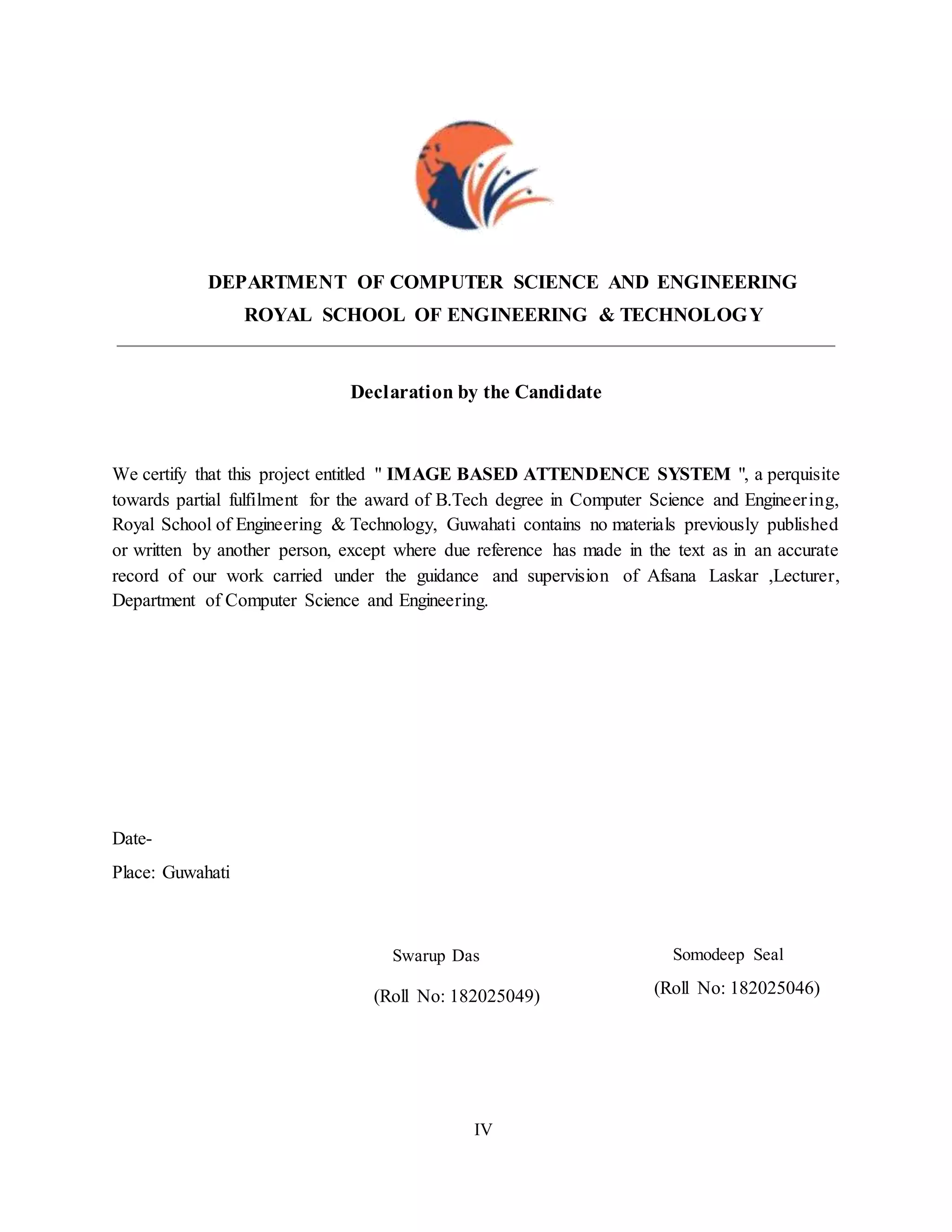

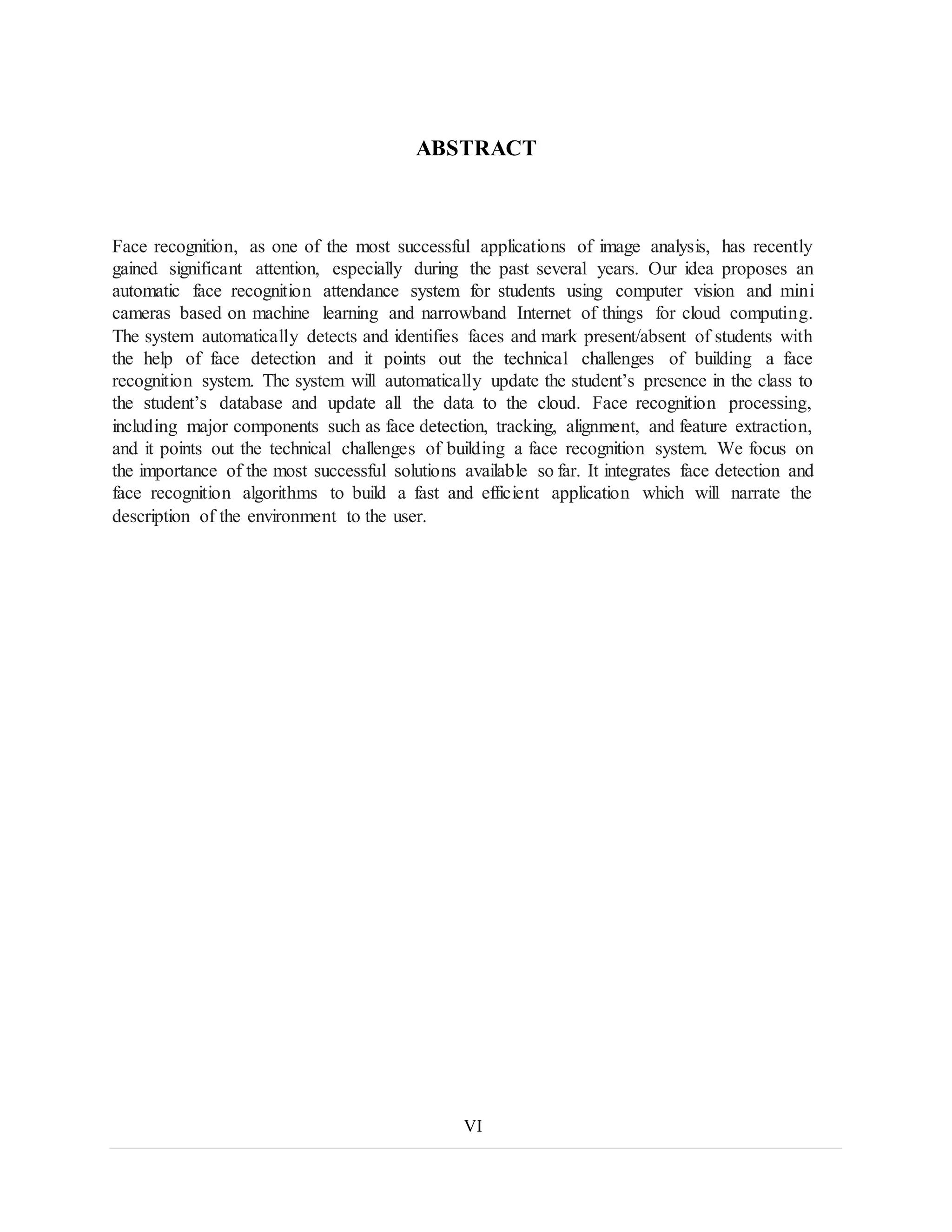




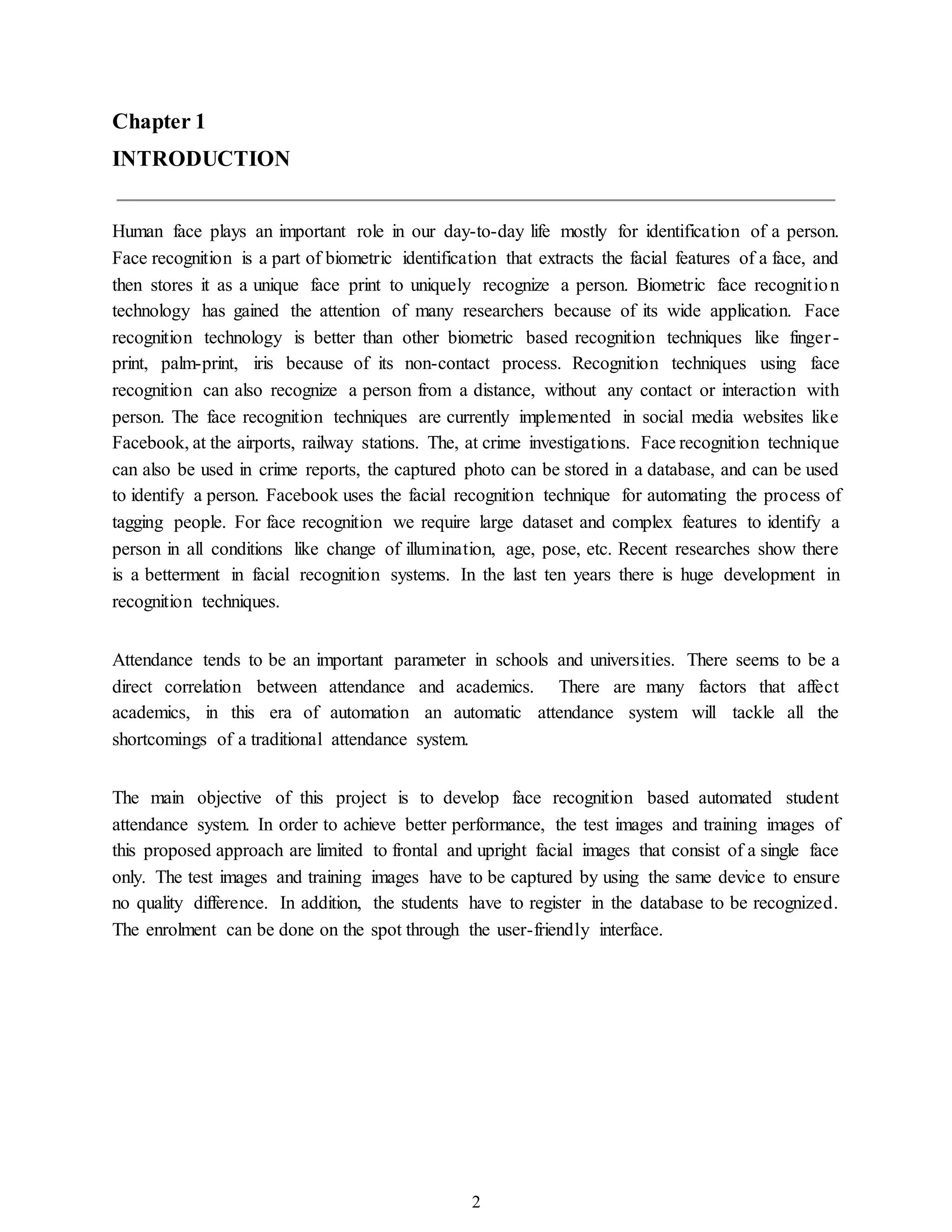


![5
1.4 Aims and Objectives
The objective of this project is to develop face recognition based automated student attendance
system. Expected achievements in order to fulfil the objectives are:
To detect the face segment from the video frame.
To extract the useful features from the face detected.
To classify the features in order to recognize the face detected.
To record the attendance of the identified student.
Fig.1.1 from [1]](https://image.slidesharecdn.com/somodeep11-220127100442/75/Face-detection-16-2048.jpg)
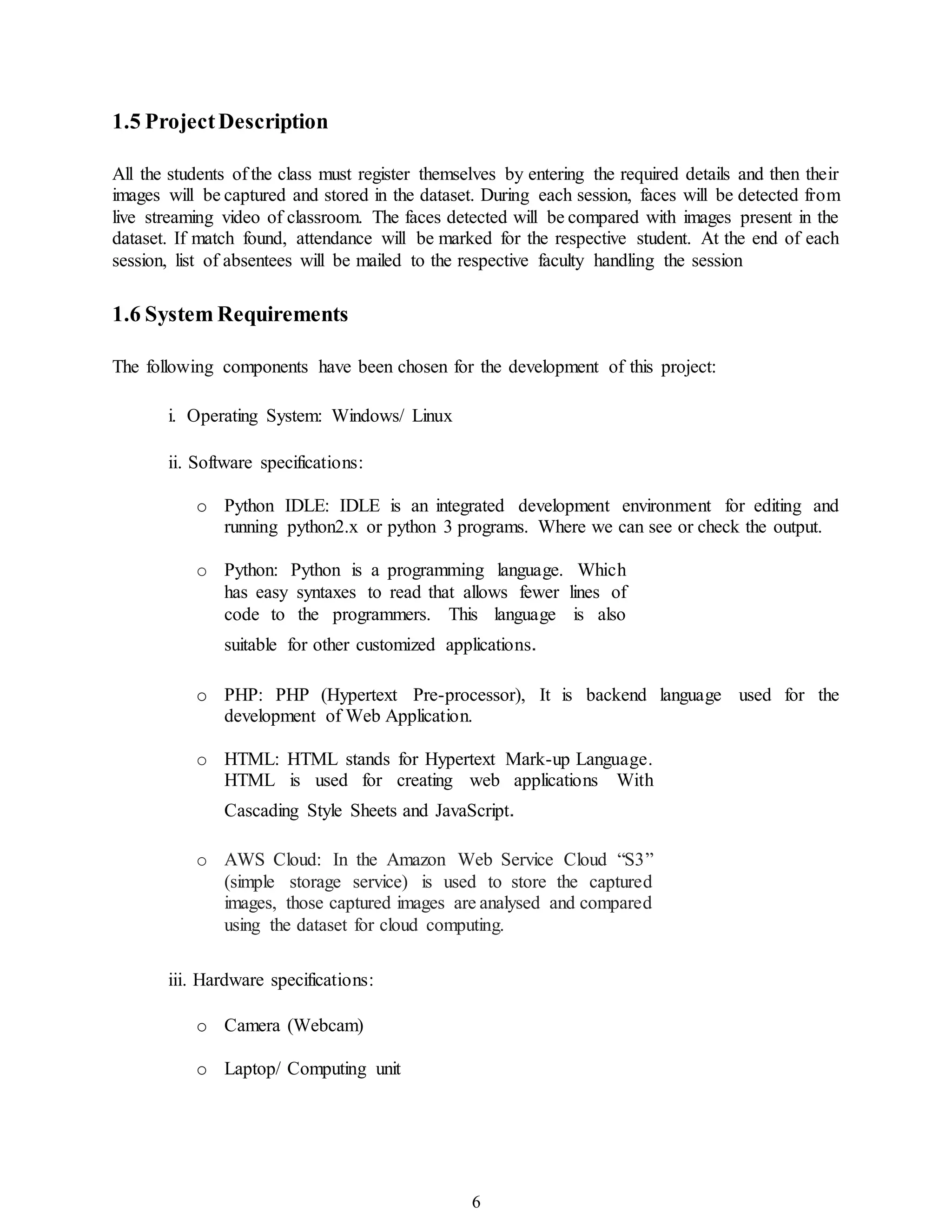
![7
Chapter 2
LITERATURE REVIEW
Arun Katara et al. (2017) mentioned disadvantages of RFID (Radio Frequency Identification) card
system, fingerprint system and iris recognition system. RFID card system is implemented due to
its simplicity. However, the user tends to help their friends to check in as long as they have their
friend’s ID card. The fingerprint system is indeed effective but not efficient because it takes time
for the verification process so the user has to line up and perform the verification one by one.
However, for face recognition, the human face is always exposed and contain less information
compared to iris. Iris recognition system which contains more detail might invade the privacy of
the user. Voice recognition is available, but it is less accurate compared to other methods. Hence,
face recognition system is suggested to be implemented in the student attendance system.
Authors in [3] proposed a model of an automated attendance system. The model focuses on how
face recognition incorporated with Radio Frequency Identification (RFID) detect the authorized
students and counts as they get in and get out form the classroom. The system keeps the authentic
record of every registered student. The system also keeps the data of every student registered for
a particular course in the attendance log and provides necessary information according to the need.
A plan and execution of a remote iris acknowledgment participation in the board framework. Iris’s
acknowledgment check is one of the most dependable individual recognizable proof techniques in
biometrics. This framework-based biometrics and remote method takes care of the issue of
misleading participation and the issue of laying the relating system.
Strong Face Recognition by means of Adaptive Sparse Representation. Inadequate Representation
(or coding) based Classification (SRC) has increased incredible accomplishment in face
acknowledgment as of late](https://image.slidesharecdn.com/somodeep11-220127100442/75/Face-detection-18-2048.jpg)
![8
Chapter 3
Image Pre-Processing
Image pre-processing is the term for operations on images at the lowest level of abstraction.
These operations do not increase image information content but they decrease it if entropy is
an information measure. The aim of pre-processing is an improvement of the image data that
suppresses undesired distortions or enhances some image features relevant for further
processing and analysis task.
Think of image pre-processing as a sound system with a range of controls, such as raw sound with
no volume controls; volume control with a simple tone knob; volume control plus treble, bass, and
mid; or volume control plus a full graphics equalizer, effects processing, and great speakers in an
acoustically superior room
3.1 Problems to Solve During Image Pre-Processing
Image pre-processing by following the vision pipelines of four fundamental families of feature
description methods
Local Binary Descriptors (LBP, ORB, FREAK, others)
Spectra Descriptors (SIFT, SURF, others)
Basis Space Descriptors (FFT, wavelets, others)
Polygon Shape Descriptors (blob object area, perimeter, centroid)
Fig.3.1 from [2]](https://image.slidesharecdn.com/somodeep11-220127100442/75/Face-detection-19-2048.jpg)


![11
Chapter 4
PROJECTBACKGROUND
4.1 Face Detection
Face detection is a computer technology being used in a variety of applications that identifies
human faces in digital images. Face detection also refers to the psychological process by which
humans locate and attend to faces in a visual scene.
4.1.1 HaarCascade
So, what is Haar Cascade? It is an Object Detection Algorithm used to identify faces in an image
or a real time video. The algorithm uses edge or line detection features proposed by Viola and
Jones in their research paper “Rapid Object Detection using a Boosted Cascade of Simple
Features” published in 2001. The algorithm is given a lot of positive images consisting of faces,
and a lot of negative images not consisting of any face to train on them.
Fig.4.1 Block diagram [1]](https://image.slidesharecdn.com/somodeep11-220127100442/75/Face-detection-22-2048.jpg)
![12
4.1.2 Feature ofHaar Cascade
Fig 4.2 The rectangle on the left is a sample representation of an image with pixel values 0.0 to
1.0. The rectangle at the center is a haar kernel which has all the light pixels on the left and all the
dark pixels on the right. The haar calculation is done by finding out the difference of the average
of the pixel values at the darker region and the average of the pixel values at the lighter region. If
the difference is close to 1, then there is an edge detected by the haar feature
A sample calculation of Haar value from a rectangular image section has been shown here. The
darker areas in the haar feature are pixels with values 1, and the lighter areas are pixels with values
0. Each of these is responsible for finding out one particular feature in the image. Such as an edge,
a line or any structure in the image where there is a sudden change of intensities. For ex. in the
image above, the haar feature can detect a vertical edge with darker pixels at its right and lighter
pixels at its left.
The objective here is to find out the sum of all the image pixels lying in the darker area of the
haar feature and the sum of all the image pixels lying in the lighter area of the haar feature. And
then find out their difference. Now if the image has an edge separating dark pixels on the right and
light pixels on the left, then the haar value will be closer to 1. That means, we say that there is an
edge detected if the haar value is closer to 1. In the example above, there is no edge as the haar
value is far from 1.
Fig.4.2 Haar Cascade [1]](https://image.slidesharecdn.com/somodeep11-220127100442/75/Face-detection-23-2048.jpg)

![14
4.3 FLOW DIAGRAM
Fig.4.3 Diagram of real time face recognition system [6]](https://image.slidesharecdn.com/somodeep11-220127100442/75/Face-detection-25-2048.jpg)
![15
4.4 Some face detectionmodels
Face detection is one of the most fundamental aspects of computer vision. It is the base of many
further studies like identifying specific people to marking key points on the face.
Some pre-trained models like
Haar Cascades
It is super fast to work with and like the simple CNN, it extracts a lot of features from images. The
best features are then selected via Adaboost. This reduces the original 160000+ features to 6000
features. But applying all these features in a sliding window will still take a lot of time. So they
introduced a Cascade of Classifiers, where the features are grouped. If a window fails at the first
stage, these remaining features in that cascade are not processed. If it passes then the next feature
is tested and the same procedure is repeated. If a window can pass all the features then it is
classified as a face region.
Dlib Frontal Face Detector
Dlib is a C++ toolkit containing machine learning algorithms used to solve real-world problems.
Although it is written in C++ it has python bindings to run it in python. It also has the great facial
landmark keypoint detector which I used in one of my earlier articles to make a real-time gaze
tracking system.
The frontal face detector provided by dlib works using features extracted by Histogram of Oriented
Gradients (HOG) which are then passed through an SVM. In the HOG feature descriptor, the
distribution of the directions of gradients is used as features. Moreover, Dlib provides a more
advanced CNN based face detector
Fig.4.4 Haar Cascade [7]](https://image.slidesharecdn.com/somodeep11-220127100442/75/Face-detection-26-2048.jpg)
![16
MTCNN
It was introduced by Kaipeng Zhang, et al. in 2016 in their paper, “Joint Face Detection and
Alignment Using Multi-task Cascaded Convolutional Networks.” It not only detects the face but
also detects five key points as well. It uses a cascade structure with three stages of CNN. First,
they use a fully convolutional network to obtain candidate windows and their bounding box
regression vectors, and the highly overlapped candidates are overlapped using on-maximum
suppression (NMS). Next, these candidates are passed to another CNN which rejects a large
number of false positives and performs calibration of bounding boxes. In the final stage, the facial
landmark detection is performed.
DNN Face Detectorin OpenCV
It is a Caffe model which is based on the Single Shot-Multibox Detector (SSD) and uses ResNet-
10 architecture as its backbone. It was introduced post OpenCV 3.3 in its deep neural network
module. There is also a quantized Tensorflow version that can be used but we will use the Caffe
Model
Fig.4.5 MTCNN [8]
Fig.4.6 DNN [9]](https://image.slidesharecdn.com/somodeep11-220127100442/75/Face-detection-27-2048.jpg)
![17
YOLO
YOLO algorithm employs convolutional neural networks (CNN) to detect objects in real-time.
The algorithm requires only a single forward propagation through a neural network to detect
objects. The CNN is used to predict various class probabilities and bounding boxes simultaneous ly.
YOLO divides every image into a grid of S x S and every grid predicts N bounding boxes and
confidence. The confidence reflects the precision of the bounding box and whether the bounding
box in point of fact contains an object in spite of the defined class. YOLO even forecasts the
classification score for every box for each class.
Fig.4.7 Working of YOLO model[13]](https://image.slidesharecdn.com/somodeep11-220127100442/75/Face-detection-28-2048.jpg)

![19
4.5.2 FaceLandmark Estimation
The basic idea in Face landmark Estimation is to come up with 68 specific points (called
landmarks) that exist on every face — the top of the chin, the outside edge of each eye, the inner
edge of each eyebrow, etc. Then a machine learning algorithm finds these 68 specific points on
any face. Then the image is sheared so that the eyes and mouth are centered as best as possible.
The aim is that no matter how the face is turned, the facial features should be centered.
4.5.3 Encoding of faces
Deep Convolutional Neural Networks are trained to generate 128 measurements(embedding) for
each face. The embeddings are basically numbers generated by the neural network. The embedding
of a face is compared to all the embedding of an already known face to determine the person’s
name.
Fig.4.8 Flowchart of stages of face recognition. [14]
Fig.4.9 68 face landmarks [7]](https://image.slidesharecdn.com/somodeep11-220127100442/75/Face-detection-30-2048.jpg)

![21
5.2 Face Detection
Viola-Jones object detection framework will be used to detect the face from the video camera
recording frame. The working principle of Viola-Jones algorithm is mentioned. The limitation of
the Viola-Jones framework is that the facial image has to be a frontal upright image, the face of
the individual must point towards the camera in a video frame.
5.3 Pre-Processing
Testing set and training set images are captured using a camera. There are unwanted noise and
uneven lighting exists in the images. Therefore, several pre-processing steps are necessary before
proceeding to feature extraction.
Pre-processing steps that would be carried out include scaling of image, median filtering,
conversion of colour images to grayscale images and adaptive histogram equalization.
5.3.1 Scaling ofImage
Scaling of images is one of the frequent tasks in image processing. The size of the images has to
be carefully manipulated to prevent loss of spatial information. (Gonzalez, R. C., & Woods, 2008),
In order to perform face recognition, the size of the image has to be equalized. This has become
crucial, especially in the feature extraction process, the test images and training images have to be
in the same size and dimension to ensure the precise outcome. Thus, in this proposed approach test
images and train images are standardize at size 250 × 250 pixels.
5.3.2 MedianFiltering
Median filtering is a robust noise reduction method. It is widely used in various applications due
to its capability to remove unwanted noise as well as retaining useful detail in images. Since the
colour images captured by using a camera are RGB images, median filtering is done on three
different channels of the image. If the input image is a grayscale image, then the median filtering
can be performed directly without separating the channels
5.3.3 Conversionto Grayscale Image
Camera captures color images, however the proposed contrast improvement method CLAHE can
only be performed on grayscale images. After improving the contrast, the illumination effect of
the images able to be reduced. LBP extracts the grayscale features from the contrast improved
images as 8 bit texture descriptor (Ojala, T. et al., 2002).Therefore, color images have to be
converted to grayscale images before proceeding to the later steps. By converting color images to
grayscale images, the complexity of the computation can be reduced resulting in higher speed of
computation (Kanan and Cottrell, 2012). Figure shows the conversion of images to grayscale
image.
Fig.5.1 conversion of greyscale [3]](https://image.slidesharecdn.com/somodeep11-220127100442/75/Face-detection-32-2048.jpg)
![22
5.3.4 ContrastLimited Adaptive Histogram Equalization
Histogram equalization or histogram stretching is a technique of image contrast
Enhancement. The contrast improvement is usually performed on the grayscale images. Image
contrast is improved by stretching the range of its pixel intensity values to span over the desired
range of values, between 0 and 255 in grayscale. The reason that Contrast Limited Adaptive
Histogram Equalization (CLAHE) is used instead of histogram equalization is because histogram
equalization depends on the global statistics. Hence, it causes over enhancement of some parts of
image while other parts are not enhanced properly. This distorts the features of the image. It is a
serious issue because the features of the image have to be extracted for the face recognition
5.4 Block Diagram
Fig.5.2 Flow of the Proposed Approach (Training Part) [8]](https://image.slidesharecdn.com/somodeep11-220127100442/75/Face-detection-33-2048.jpg)
![23
Fig.5.3 Flow of the Proposed Approach (Recognition Part) [8]](https://image.slidesharecdn.com/somodeep11-220127100442/75/Face-detection-34-2048.jpg)
![24
Chapter 6
IMPLEMENTATION
We propose a low-cost solution in recording student attendance by employing face detection
technique. Our solution consists of four stages: Data set creation, face detection, Face recognition
and output. We named our proposed solution Image Based Attendance System. The system is
designed to improve the time efficiency and to reduce the staff-workload, which would ultimately
improve the reliability of the attendance record.
6.1 DatasetCreation
Images of students are captured using a web cam. Multiple images of single student will be
acquired with varied gestures and angles. These images undergo pre-processing. The images are
cropped to obtain the Region of Interest (ROI) which will be further used in recognition process.
Next step is to resize the cropped images to particular pixel position. Then these images will be
converted from RGB to gray scale images. And then these images will be saved as the names of
respective student in a folder.
6.2 Face Detection
Face detection here is performed using Haar-Cascade Classifier with OpenCV. Haar Cascade
algorithm needs to be trained to detect human faces before it can be used for face detection. This
is called feature extraction. The haar cascade training data used is an xml file haarcascade_
frontalface default. The haar features shown in Fig. will be used for feature extraction.
Fig.6.1 Haar Feature [1]](https://image.slidesharecdn.com/somodeep11-220127100442/75/Face-detection-35-2048.jpg)
![25
Here we are using detectMultiScale module from OpenCV. This is required to create a rectangle
around the faces in an image. It has got three parameters to consider- scaleFactor, minNeighbors,
minSize. scaleFactor is used to indicate how much an image must be reduced in each image scale.
minNeighbors specifies how many neighbors each candidate rectangle must have. Higher values
usually detects less faces but detects high quality in image. minSize specifies the minimum object
size. By default, it is (30,30) [8]. The parameters used in this system is scaleFactor and
minNeighbors with the values 1.3 and 5 respectively.
6.3 Face Recognition
Face recognition process can be divided into three stepsprepare training data, train face recognizer,
prediction. Here training data will be the images present in the dataset. They will be assigned with
a integer label of the student it belongs to. These images are then used for face recognition. Face
recognizer used in this system is Local Binary Pattern Histogram. Initially, the list of local binary
patterns (LBP) of entire face is obtained. These LBPs are converted into decimal number and then
histograms of all those decimal values are made. At the end, one histogram will be formed for each
images in the training data. Later, during recognition process histogram of the face to be
recognized is calculated and then compared with the already computed histograms and returns the
best matched label associated with the student it
belongs to [9].
6.4 Output/Attendance Updation
After face recognition process, the recognized faces will be marked as present in the excel sheet
and the rest will be marked as absent and the list of absentees will be mailed to the respective
faculties. Faculties will be updated with monthly attendance sheet at the end of every month.](https://image.slidesharecdn.com/somodeep11-220127100442/75/Face-detection-36-2048.jpg)
![26
6.5 Algorithm of working process
Fig.6.2 Algorithm [5]](https://image.slidesharecdn.com/somodeep11-220127100442/75/Face-detection-37-2048.jpg)
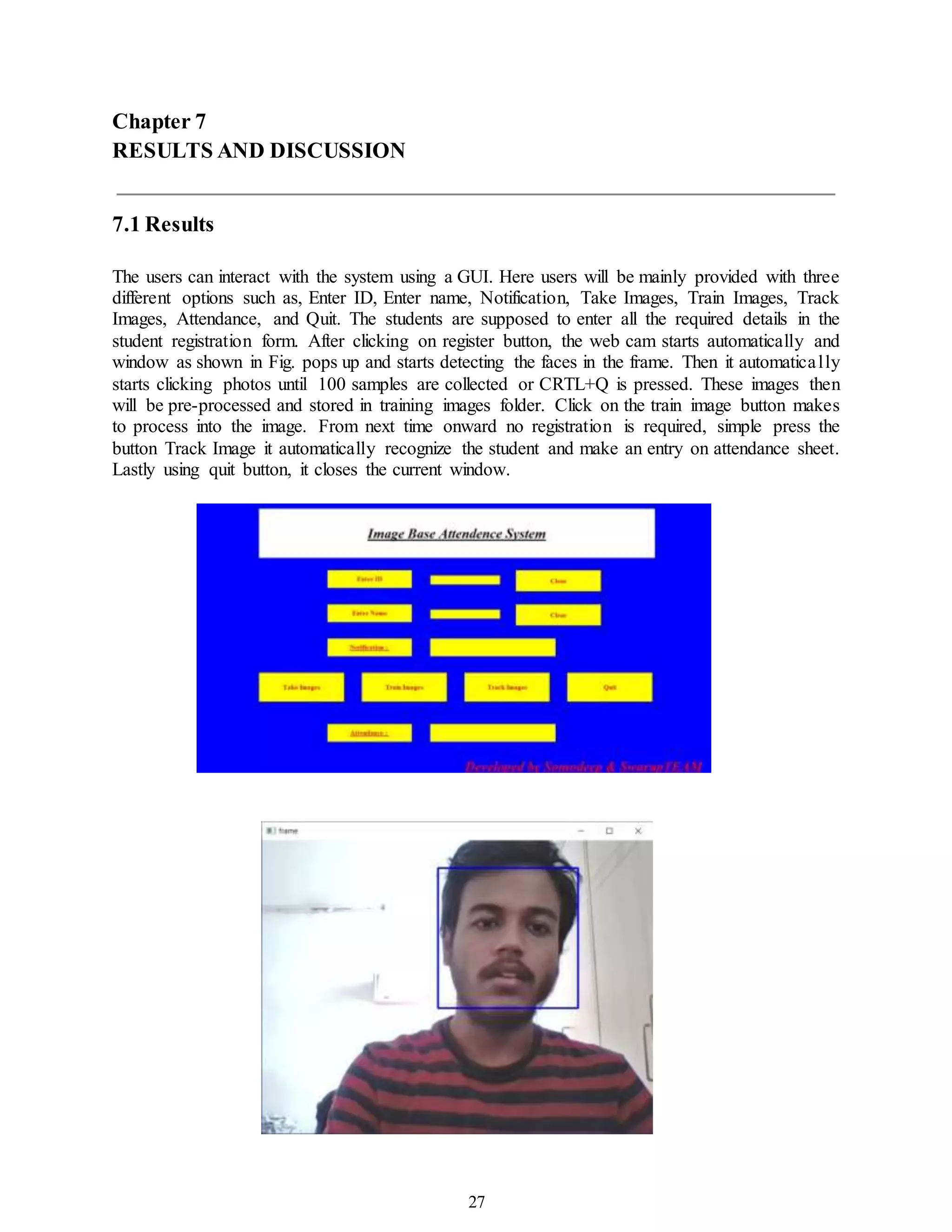




![32
References
1. Chin, H. (2018). Face recognition based automated student attendance system (Doctoral
dissertation, UTAR).
2. Krig, Scott. Computer vision metrics: Survey, taxonomy, and analysis. Springer Nature, 2014.
3. Cuimei, L., Zhiliang, Q., Nan, J., & Jianhua, W. (2017, October). Human face detection algorithm
via Haar cascade classifier combined with three additional classifiers. In 2017 13th IEEE
International Conference on Electronic Measurement & Instruments (ICEMI) (pp. 483-487). IEEE.
4. Sidney Fussell. (2018). NEWS Facebook's New Face Recognition Features: What We Do (and Don't) Know.
[online] Available at: https://gizmodo.com/facebooks-new-face-recognition-features-what-we-do-an-
1823359911 [Accessed 25 Mar. 2018].
5. Tabora, V. (2011). Face Detection Using OpenCV With Haar Cascade Classifiers. línea]. Available:
https://becominghuman. ai/face-detection-using-opencv-with-haarcascade-classifiers-
941dbb25177.[Último acceso: 12 08 2019].
6. Kar, N., Debbarma, M. K., Saha, A., & Pal, D. R. (2012). Study of implementing automated
attendance system using face recognition technique. International Journal of computer and
communication engineering, 1(2), 100.
7. Kim, M., Lee, D., & Kim, K. Y. (2015). System architecture for real-time face detection on analog
video camera. International Journal of Distributed Sensor Networks, 11(5), 251386.
8. Kaziakhmedov, Edgar, Klim Kireev, Grigorii Melnikov, Mikhail Pautov, and Aleksandr Petiushko.
"Real-world attack on MTCNN face detection system." In 2019 International Multi-Conference on
Engineering, Computer and Information Sciences (SIBIRCON), pp. 0422-0427. IEEE, 2019.
9. Chintalapati, S., & Raghunadh, M. V. (2013, December). Automated attendance management
system based on face recognition algorithms. In 2013 IEEE International Conference on
Computational Intelligence and Computing Research (pp. 1-5). IEEE.
10.Raja, R. "Face recognition using OpenCV and Python: A beginner’s guide. Retrieved May 26, 2020."
(2020).
11.D'Souza, J. W., Jothi, S., & Chandrasekar, A. (2019, March). Automated attendance marking and
management system by facial recognition using histogram. In 2019 5th International Conference on
Advanced Computing & Communication Systems (ICACCS) (pp. 66-69). IEEE.
12.Balcoh, N. K., Yousaf, M. H., Ahmad, W., & Baig, M. I. (2012). Algorithm for efficient attendance
management: Face recognition based approach. International Journal of Computer Science Issues
(IJCSI), 9(4), 146.
13.Tian, Y., Yang, G., Wang, Z., Wang, H., Li, E., & Liang, Z. (2019). Apple detection during different
growth stages in orchards using the improved YOLO-V3 model. Computers and electronics in
agriculture, 157, 417-426.
14.Indra, Evta, Muhammad Yasir, Andrian Andrian, Delima Sitanggang, Oloan Sihombing, Saut
Parsoran Tamba, and Elviana Sagala. "Design and Implementation of Student Attendance System
Based on Face Recognition by Haar-Like Features Methods." In 2020 3rd International Conference
on Mechanical, Electronics, Computer, and Industrial Technology (MECnIT), pp. 336-342. IEEE,
2020.
15.Chin, H., Cheah, K. H., Nisar, H., & Yeap, K. H. (2019, September). Enhanced Face Recognition
Method Based On Local Binary Pattern and Principal Component Analysis For Efficient Class
Attendance System. In 2019 IEEE International Conference on Signal and Image Processing
Applications (ICSIPA) (pp. 23-28). IEEE.
16.Zhang, S., Wen, L., Shi, H., Lei, Z., Lyu, S., & Li, S. Z. (2019). Single-shot scale-aware network for
real-time face detection. International Journal of Computer Vision, 127(6), 537-559.
17.Fleischer, Rachel S. "BIAS IN, BIAS OUT: WHY LEGISLATION PLACING REQUIREMENTS ON
THE PROCUREMENT OF COMMERCIALIZED FACIAL RECOGNITION TECHNOLOGY MUST
BE PASSED TO PROTECT PEOPLE OF COLOR." Public Contract Law Journal 50, no. 1 (2020):
63-89.
18.Mahesh, PC Senthil, K. Sasikala, and M. Rudra Kumar. "Face Recognition Based Automated
Student Attendance System using Deep Learning." International Journal 9, no. 3 (2020).](https://image.slidesharecdn.com/somodeep11-220127100442/75/Face-detection-43-2048.jpg)
